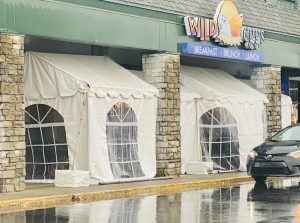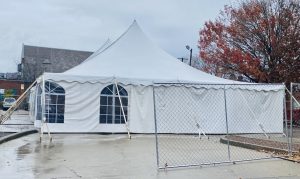As a second surge of COVID-19 cases spreads across Kentucky, indoor dining is once again restricted. As the weather begins to turn colder, restaurants in a last-ditch effort to survive are scrambling to erect tents to continue to serve patrons in an outdoor dining environment.
I respect their efforts and up until now, restaurants have been able to rely on their sidewalks and outdoor patios to allow their patrons to properly social distance. However, they are now looking for ways to provide greater distance and warmth for their outdoor patrons, as many jurisdictions have allowed the use of tents among restaurants and other businesses.
Many of these new tent structures come in varying forms, materials, and styles; from clear plastic tents that allow just a few people to eat together to large canvass type tents designed for outdoor catering events. As a result, this has created a bit of a debate amongst the infection control specialist as some are questioning if dining in enclosed outdoor tents is any safer than dining indoors in the comforts of a warm dining area.
However, like the little boy in the Bruce Willis movie “The Sixth Sense,” as a risk management and safety professional, I see dangers everywhere and it’s not just an airborne virus.
Are these tents properly anchored into place and if not will it blow away injuring the patrons when a storm was to blow through? How are these restaurants heating these outdoor dining spaces? Are they creating an additionally hazardous airborne hazard called carbon monoxide? Being located in parking lots and next to roadways, will a vehicle plow into these temporary structures and injure or kill an unsuspecting patron?
In the early 1990s, while in college at Eastern Kentucky University working on my Masters in Loss Prevention and Safety, we all learned of all the man-made disasters and tragedies that helped form my profession and countless safety standards and fire codes.
The one tragedy that stands out to me the most in this situation was the Hartford Circus Fire, which occurred on July 6, 1944, in Hartford, Connecticut. The fire broke out during a Ringling Bros. and Barnum & Bailey Circus performance where 6,000 to 8,000 people were in attendance. It was one of the worst fire disasters in United States history, killing 167 people and injuring more than 700 others. The origins of the fire were never determined, but it was suspected to be either arson or a carelessly discarded cigarette.
Because of the paraffin wax waterproofing of the tent, the flames spread rapidly, helped by the wind. The waterproofing indeed protected the tent from the rain, but it was extremely flammable. Many people were badly burned by the melting paraffin, which rained down from the roof. The fiery tent collapsed in about eight minutes according to eyewitness survivors, trapping hundreds of spectators beneath it.
Because these tents are temporary structures, many assume that precautions for fire protection and life safety aren’t needed since these structures are outdoors.
According to a National Fire Protection Association article dated July 20, when erecting a tent or membrane structure, multiple safety precautions must be followed. Restaurants, businesses, or other groups planning to use a tent must contact their local and state authority having jurisdiction and that all applicable requirements should be followed; all plans for tent usage should be reviewed by a qualified person.
NFPA 101, Life Safety Code, and NFPA 1, Fire Code, contain requirements that address the use of tents and membrane structures, including a provision stating that tents can only be used temporarily and should not be erected for more than 180 days. Also, the means of egress must comply with the requirements for the occupancy of the tent. Additional egress features should include exit markings and emergency lighting within the tent, along with measures to ensure that exits from the tent cannot be blocked.
Both NFPA 1 and NFPA 101 require that tent material meets the flame propagation performance requirements of NFPA 701, Standard Methods of Fire Tests for Flame Propagation of Textiles and Films. This is a test performed on the fabric of the tent by a testing organization, which will issue a certificate if the fabric has passed the test.
 Keven Moore works in risk management services. He has a bachelor’s degree from the University of Kentucky, a master’s from Eastern Kentucky University and 25-plus years of experience in the safety and insurance profession. He is also an expert witness. He lives in Lexington with his family and works out of both Lexington and Northern Kentucky. Keven can be reached at kmoore@roeding.com
Keven Moore works in risk management services. He has a bachelor’s degree from the University of Kentucky, a master’s from Eastern Kentucky University and 25-plus years of experience in the safety and insurance profession. He is also an expert witness. He lives in Lexington with his family and works out of both Lexington and Northern Kentucky. Keven can be reached at kmoore@roeding.comIn Kentucky, permits are required for all tents and temporary structures which are more than 120 sq. ft. and this is regulated by the Kentucky Building Code. Before obtaining your tent permit, you will need a Zoning Compliance Permit which is issued by the Division of Planning. Tents that are greater than 400 sq ft in the area may need a Kentucky Temporary Structures (KTS) model approval letter.
Temporary structures that are not required to obtain a KTS model approval letter are tents used for recreational camping; individual fabric canopies which are open on all sides having a maximum size of 700 sq. ft. or multiple canopies placed side by side not exceeding 700 sq. ft; and temporary structures utilized for a private event as defined by the Kentucky Building Code.
Here are some additional safety considerations to be taken into account when erecting these temporary outdoor dining structures.
• All tents and membrane structure locations must be approved by the AHJ, who could be the local building department or fire department official in charge of inspecting and approving the use of the structure.
• All tents and membrane structures should not block fire department access and should not be located too close to other buildings or lot lines.
• All tents and membrane structures should not block the means of egress from other buildings.
• All tents and membrane structures should have at least a 10 ft (3 m) distance around the tent that is free of combustible material and all combustible waste should not be stored within 30 feet from the temporary structure.
• All tents and membrane structures should maintain a distance of at least 10 ft (3 m) between stake lines of multiple tents to provide means of egress from the tents.
• All tents and membrane structures should maintain adequate emergency exit access from the restaurant or business that was in place before the placement of the outside tents or membrane structures must be maintained.
• All tents and membrane structures must be adequately roped, braced, and anchored to withstand prevalent weather conditions. All tents and membrane structures should be properly secure in case of wind (40MPH basic wind speed and 90 mph 3-second gust).
• The number of exits that are required in a tent or membrane structure is set by rule and depends on the occupant load and approved by your AHJ. They should all be marked and lighted.
• Egress pathways inside the tent must remain clear and unobstructed at all times (including from electrical cords, ropes, guy wires, and anchors).
• Aisle ways inside the tents and membrane structures must be provided from seating areas and must remain unobstructed and should have a minimum width of no less than 44 inches.
• All tents and membrane structures should have a permanently affixed label bearing the tent or membrane structure size and fabric or material type.
• In addition to affixed labels, owners of tents and membrane structures should have documentation demonstrating compliance with the National Fire Protection Association (NFPA) 701 ASTM E84 testing requirements.
• All tents and other membrane structures should be flame retardant and comply with Chapter 31 of the 2015 International Fire Code standards.
• Smoking should not be permitted in tents or membrane structures and “no smoking signs must be posted. Open flames.
• Flammable or combustible liquids, gas, charcoal, or other cooking device should be forbidden inside the tent.
• Fire extinguishers should be accessible within 75 feet walking distance and their locations identified inside the tent.
• Open flames are also not permitted within 20 feet of any tent or membrane structure open to the public unless approved by the fire code official. For this purpose, the term “open flames” includes candles and/or any device emitting a flame fire or heat.
• Generators and other internal combustion power sources including liquid fuel for diesel fuel, must also be isolated from contact with the public by fencing, enclosure, or other approved means.
• All flammable gas and liquids should be labeled, properly stored to prevent accidental toppling and a secured to prevent tampering.
• Portable outdoor gas-fired heating appliances are prohibited in tents and membrane structures.
• Electrical heating sources must comply with NFPA 70.
• Outdoor cooking that produces sparks or grease-laden vapors cannot be performed within 20 feet of a tent or membrane structure.
• Flammable liquid-fueled equipment cannot be used inside tents or membrane structures.
• LP-gas equipment must comply with O.F.C. Rule 61 and the International Fuel Gas Code and must be separated from tents and membrane structures by specified distances depending on the size of the container.
• Temporary electrical wiring must comply with the National Electric Code (NEC).
• All electrical cords must be protected from GFCI, even those connected to portable generators.
Be safe, my friends.

























